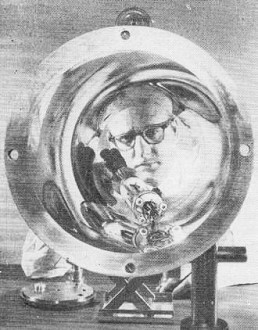October 1959 Popular Electronics
 Table
of Contents Table
of Contents
Wax nostalgic about and learn from the history of early electronics. See articles
from
Popular Electronics,
published October 1954 - April 1985. All copyrights are hereby acknowledged.
|
Albert Einstein published
his paper on Special Relativity in 1905 and on General Relativity in 1916. Since
that time, many experiments have been performed worldwide by scientists intent on
both proving and disproving Mr. Einstein. Laser and nuclear based timepieces have
been improved for precision and calculations refined to aid in the task. This
1959 Popular Electronics magazine article reports on one of the first
atomic clock experiments used to test General Relativity. After more than
100 years, General Relativity stands as originally presented. Even the rigors of quantum mechanics,
which Einstein did not embrace until much later in life,
has not toppled its precepts.
Atomic Clock to Check Einstein

Dr. Harold Lyons examines the tubular heart of the atomic clock
which will be rocketed into space to test Einstein's two theories of relativity.
There once was a Miss Fanny Bright Whose speed was much greater than light
She set out one day In a relative way And arrived the previous night
According to Einstein's theory of relativity, if you were to travel in space
for 20 years at the speed of light (186,000 miles per second), you would return
to find the earth millions of years older. In the topsy-turvy world of relativity,
where space and time merge into one and the same thing, the average person tends
to be incredulous about the whole thing. But you can't argue about the existence
of atomic bombs - which were developed according to Einstein's "theories." And now
a most critical check of the special and general relativity theories is being planned.
Dr. Harold Lyons, head of Hughes Aircraft's atomic physics department, is supervising
the design of a 30-pound atomic "clock" which will be rocketed into space to "keep
time" as it orbits around the earth through varying intensities of the earth's gravitational
field. More accurate than any other time device in existence, the atomic clock will
lose or gain less than one second in a thousand years. It bears no resemblance to
an ordinary clock - having no arms or face - and in truth is more oscillator than
clock. It looks something like a foot-long electron tube.
Before being launched, the atomic clock will be synchronized with a similar clock
on the ground. Then, as it orbits through space at 18,000 miles per hour, it will
generate an alternating current at a frequency of 24 billion cycles per second.
For purposes of measurement, this extremely high frequency will be converted to
a frequency more convenient for use with earth-based laboratory instruments. This
information will then be radioed to earth and the time on the orbiting clock will
be compared with the time on the earth clock.
It is expected that the satellite clock will run slow in comparison with the
ground clock as it passes through orbits below 2000 miles because, according to
the special theory of relativity, motional effects should predominate below that
altitude. Above 2000 miles, the clock should run fast in order to bear out the general
theory of relativity; at higher altitudes, the effects of the earth's gravity will
be less.
Since the effects of motion and gravity are opposite, as the satellite goes through
the 2000-mile point, they should cancel out and the two clocks should agree. Thus
both the special and general relativity theories will be checked.
The importance of the experiment was pointed out by Dr. Lyons, who stated, "Any
experiment that puts the general theory of relativity on a firmer physical basis
would spur much significant work in the space and nuclear ages." With an actual
clock-launching probably only several years off, the entire scientific world eagerly
awaits the results.
Posted November 12, 2020
(updated from original post on 1/27/2013)
|





























